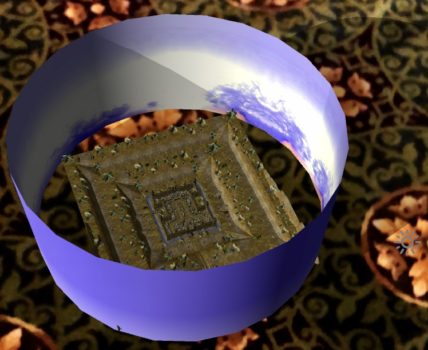When you think of university level English education, an AR game might not be the first thing that comes to mind.
However, with the current availability of powerful cellphones and inexpensive standalone VR headsets, augmented and virtual reality could be regularly used in college humanities courses sooner rather than later.
In fact, two New York Institute of Technology English professors are already doing just that.

“You create more memories by using mixed realities, and students can have a lot more visceral experiences with literature and with the stories that are being told through these technologies,” English professor John Misak told Hypergrid Business.
Perchance: An AR Hamlet Mystery, aims to give students a more in-depth experience of Shakespeare’s Hamlet while also enhancing their comprehension and retention.
“I was able to create a model and put that model into AR and onto a PC that students could test out, where they got to walk around the castle where Hamlet meets his father’s ghost,” said Misak.
The key to AR’s efficacy in improving retention lies in the hippocampus, the part of the brain that plays a critical role in the formation and storage of new memories, and also connects certain sensations and emotions to these memories.
“The hippocampus incorporates your sense of place and that’s tied directly to memory, so if we can have students feel a part of the literature, they’ll better remember what it is that they’re experiencing,” said Misak, who is also lead developer of Perchance, the startup tech company behind the game.
Fellow professor and app co-developer Kevin LaGrandeur, said he is excited about the prospect of using AR to enhance traditional English education:

“My career’s been defined by exploring technology in education in various ways, so I was intrigued by the idea of using VR or AR in education because it’s the new cutting edge thing,” he told Hypergrid Business. “I’ve been trying to stay with whatever’s on the horizon.”
A study published in The Journal of Neuroscience in 2015 backs up the claim that AR or VR could improve memory retention. According to the study, understanding improved more in rich, 3D video games compared to 2D. “Our results suggest that modern day video games may provide meaningful stimulation to the human hippocampus,” the researchers wrote.
Misak and LaGrandeur tossed around the idea of developing a VR game, but settled on using AR as almost everyone has access to a cellphone, whereas the logistics of having a dedicated VR lab and having enough headsets could make the use of VR in the classroom somewhat challenging.
Misak originally taught himself how to do the coding, but eventually outsourced most of it so that he and LaGrandeur could focus on storyboarding and developing the application.
However, they might translate the app to a VR setting in the future, they said.
They’re not the only ones using virtual and augmented reality at the NY Institute of Technology.
“The medical group is working on a virtual reality surgical application where students can practice dissecting kidneys in virtual reality rather than having to dissect real kidneys,” said LaGrandeur. “It cuts the cost down of doing that exercise, and they still get the practical experience.”
Misak and LaGrandeur received a grant to set up a beta test with students from all over the school, and then polled students about their experience. More than 150 students offered feedback, saying, “It made Hamlet more interesting,” “the AR element was the best part,” and “it makes learning interactive and that helps students understand better.”
The professors were impressed by the student response: “The student feedback has been enormously helpful. Â They’ve been not just kind about it but very enthusiastic,” said LaGrandeur.
Now, the professors are trying to figure out how to get funding and how to market the game.
“We all talk about where we can get money,” said LaGrandeur. “Nobody knows quite how to market these things, how to pitch it. Â It’s all sort of a new frontier.”

Another challenge they face is getting the traditional humanities establishment to buy into the concept of using AR and VR.
“There’s always going to be a fight between people who want to keep things traditional and people that want to use cutting edge technology,” said Misak. “I think I see us as a balance between the two. Â Our app is designed to encourage reading, not replace it.”
LaGrandeur pointed out that one of the most difficult things in teaching is to arrange a class or an experience in such a way that a student learns through their own activity, a popular concept called active learning.
“The debate of what exactly it is that we want to do and how we can do it in a way that allows the students to come to their own conclusions is probably the biggest hurdle that I see in the final product,” said Misak.
You can try out the Perchance game by downloading the Kubity app for the iPhone here, or for Google Play here.
Once inside the app, you need to scan the QR code here to launch the castle simulation.

- OpenAI’s new Point-E lets you generate 3D models with text - December 21, 2022
- Celebrity Cruises unveils virtual cruise experience - December 15, 2022
- Metaverse experiences could boost real world travel - December 12, 2022
